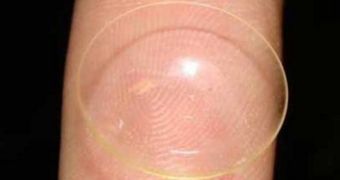Several eye diseases at this point need to be treated using a variety of chemicals and drugs, which have to be delivered efficiently to the surface of the eye. However, this seldom happens with existing medicine, simply because pouring drops of liquid on the eyeball is not the most efficient delivery mechanisms. Statistics show that only between 1 and 5 percent of the substance actually goes on to have an effect. That is why researchers have recently developed a new type of contact lens, that could take on the burden of gradually delivering medication over longer periods of time, LiveScience reports.
The concept of using lenses for drug delivery is not by far a new one. However, previous studies into these instruments have only yielded products capable of delivering their medication within an hour or so. For the treatment of conditions such as cataract and glaucoma, drugs need to be delivered a lot slower, and also at a constant pace, so that they permeate the eye. Additionally, these diseases also require more than one drug that needs to be taken two to three times per day. Switching between more than one pair of lenses, depending on which drug they carry, is very cumbersome, and impractical.
A solution to this problem comes from researchers at the University of Florida. Professor of chemical engineering Anuj Chauhan and his team have developed a lens that is capable of containing more than one medication, and also to release it over time. The group took an interesting approach to creating this device. They used vitamin E to construct walls, or “nanobricks,” between layers of various drugs, which means that drugs pushing to get out, and into the eye, take a longer time before escaping the lens. Chauhan explains that this approach extends the life-time of a drug-laden lens not by hours, but by days. In terms of comfort to the wearer, this is an amazing progress from other similar lenses.
The new lenses proved to be extremely efficient in delivering drugs, in tests that the team conducted using lab animals. Now, they are planning to conduct the same experiments on humans, in order to see if the performances hold. They say that, if successful, their vitamin E-loaded lenses could deliver their loads in a time frame 100 times longer than the one existing lenses are capable of. Human clinical trials are scheduled to go on for another five years, after which time the team is hopeful the new technology will hit the market. Details of their approach were presented recently in San Francisco, at the 239th National Meeting of the American Chemical Society (ACS).

 14 DAY TRIAL //
14 DAY TRIAL //